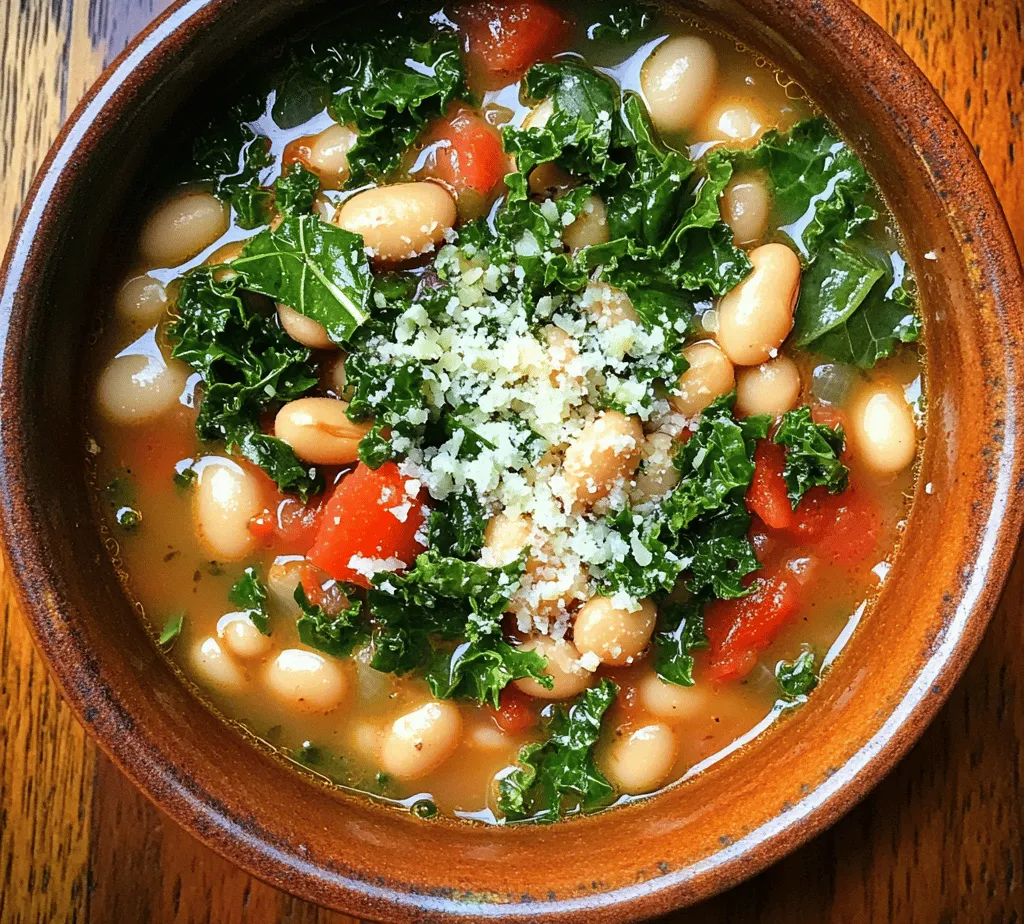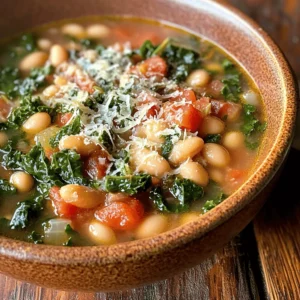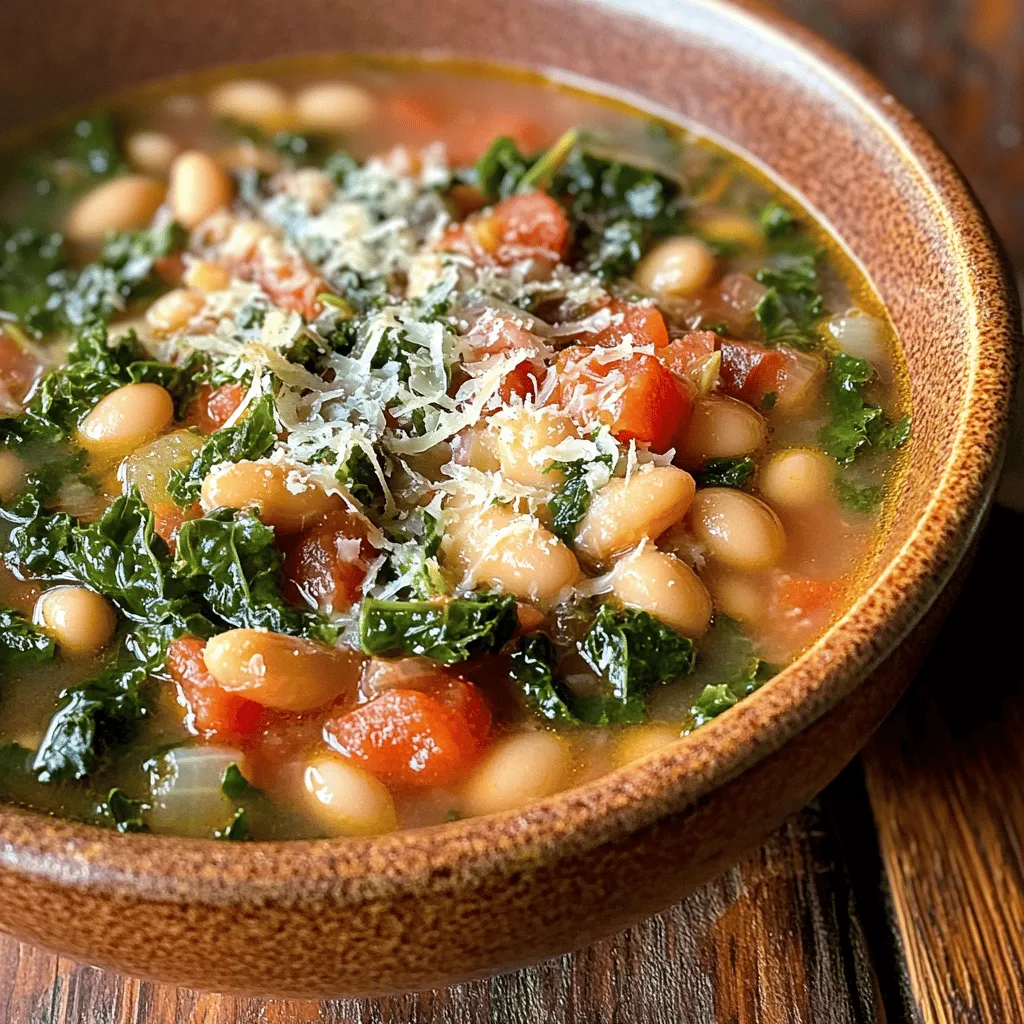Introduction to Tuscan White Bean Soup
Tuscan White Bean Soup, known as “Zuppa di Fagioli,” is a dish that beautifully captures the heart and soul of Italian cuisine. Originating from the rustic kitchens of Tuscany, this soup is a comforting blend of creamy cannellini beans, vibrant vegetables, and aromatic herbs. It’s a dish that not only warms the body but also nourishes the spirit, making it a perfect choice for any occasion. Whether you’re looking for a quick weeknight dinner or a leisurely weekend meal, this soup checks all the boxes. The balance of flavors and textures makes it a wholesome option that satisfies even the most discerning palates.
The beauty of Tuscan White Bean Soup lies in its simplicity. With just a handful of ingredients, you can create a dish that is rich in flavor and nutrition. This recipe is a testament to the Italian philosophy of using fresh, high-quality ingredients to create satisfying meals. As we embark on this culinary journey, you’ll discover how to whip up a pot of this delightful soup in your own kitchen, transforming ordinary ingredients into a bowl of warmth and comfort.
Understanding the Ingredients
Before diving into the cooking process, it’s essential to understand the key components that make Tuscan White Bean Soup a culinary masterpiece. Each ingredient plays a vital role in not only enhancing the flavor but also contributing to the nutritional profile of the dish.
The Role of Cannellini Beans
At the heart of Tuscan White Bean Soup are cannellini beans, which provide a creamy texture and a subtle nutty flavor. These white beans, native to Italy, are not only delicious but also packed with nutrients. They are an excellent source of plant-based protein, fiber, and essential vitamins and minerals, including iron and magnesium. The smooth, buttery consistency of cannellini beans makes them the perfect base for a hearty soup. When simmered, they break down slightly, thickening the broth and adding a satisfying richness that makes each spoonful comforting and fulfilling.
Vegetables: The Foundation of Flavor
Fresh vegetables are the unsung heroes of Tuscan White Bean Soup, forming the foundation of its flavor profile. Key players include onions, carrots, and celery—often referred to as the “holy trinity” of cooking. These aromatic vegetables, when sautéed, release their natural sugars and flavors, creating a savory base for the soup. Onions add a hint of sweetness, carrots contribute color and earthiness, while celery provides a refreshing crunch. Together, they create a depth of flavor that is the hallmark of a well-crafted soup.
Additionally, you can experiment with other vegetables such as garlic, bell peppers, or zucchini to enhance the soup’s flavor and nutritional value. The fresher the vegetables, the more vibrant the soup will be, so always opt for seasonal produce whenever possible.
Spices and Seasonings
The spices and seasonings are what elevate Tuscan White Bean Soup from simple to extraordinary. Fresh herbs like thyme and rosemary infuse the dish with fragrant, earthy notes that are quintessentially Italian. Thyme adds a subtle, minty flavor, while rosemary offers a robust, pine-like aroma that complements the beans beautifully.
In addition to herbs, crushed red pepper flakes can introduce a gentle heat, balancing the creamy beans and vegetables. The combination of these seasonings creates a harmonious flavor profile that results in a comforting and satisfying bowl of soup. Be sure to adjust the seasonings to your preference, as the right balance can make all the difference.
Kale: A Nutritional Powerhouse
Kale is another vital ingredient in this soup, contributing both nutrition and flavor. This leafy green is rich in vitamins A, C, and K, as well as antioxidants and fiber. It adds an earthy flavor that pairs well with the beans and enhances the overall nutritional value of the dish.
In addition to its health benefits, kale’s texture holds up beautifully during cooking, providing a pleasant chewiness that contrasts with the creamy beans. For those who prefer a milder green, Swiss chard or spinach can be used as alternatives, but kale’s robust nature truly complements the heartiness of this soup.
The Broth: A Flavorful Base
The broth is perhaps the most crucial component of Tuscan White Bean Soup, as it forms the base upon which all other flavors build. Using high-quality vegetable broth will significantly impact the soup’s overall taste. A rich, flavorful broth enhances the natural flavors of the ingredients and brings the entire dish together.
For an even deeper flavor, consider making your own broth using vegetable scraps and herbs. If time is short, store-bought broth can work wonders, but be sure to choose a low-sodium variety to control the saltiness of your soup.
Step-by-Step Guide to Making Tuscan White Bean Soup
Now that you have a good understanding of the ingredients, it’s time to dive into the step-by-step process of making this delightful Tuscan White Bean Soup.
Preparation of Ingredients
The first step to creating a delicious Tuscan White Bean Soup is to prepare all your ingredients. Start by rinsing and draining the cannellini beans if you’re using canned ones. If you’re using dried beans, soak them overnight and cook until tender.
Next, chop the vegetables. Dice the onions, carrots, and celery into uniform pieces to ensure even cooking. Mince the garlic to release its aromatic flavor. If you’re using kale, remove the tough stems and chop the leaves into bite-sized pieces. Having everything prepped and ready to go will make the cooking process smooth and efficient.
Cooking Techniques for Optimal Flavor
Once your ingredients are prepped, it’s time to start cooking. Begin by heating a generous drizzle of olive oil in a large pot over medium heat. Olive oil is not only a staple in Tuscan cooking but also adds a delicious richness to the soup.
Add the diced onions, carrots, and celery to the pot, stirring occasionally. Cook these aromatic vegetables for about 5-7 minutes until they become softened and the onions turn translucent. This sautéing technique helps to caramelize the vegetables, enhancing their natural flavors and creating a solid flavor base for the soup.
After the vegetables have softened, add the minced garlic and cook for an additional minute, allowing the garlic to become fragrant without burning.
Simmering for Flavor Development
With the vegetables sautéed, it’s time to introduce the cannellini beans and broth to the pot. Pour in the vegetable broth, ensuring that the beans are submerged. This is the moment where everything comes together. The broth will not only cook the beans but also extract their creamy essence, enriching the soup’s texture.
Bring the mixture to a gentle boil, then reduce the heat to a simmer. This low and slow cooking method allows the flavors to meld beautifully. Add the fresh thyme, rosemary, and crushed red pepper flakes at this stage, stirring to combine. Simmer the soup for about 20-30 minutes, allowing the beans to soften further and the herbs to infuse their aromatic flavors throughout the broth.
After simmering, the soup should be thick, hearty, and bursting with flavor. The combination of sautéed vegetables, creamy beans, and fragrant herbs creates a comforting dish that is sure to satisfy.
As the soup continues to simmer, prepare to add the kale in the final minutes of cooking. This will ensure that the kale retains its vibrant color and nutritional benefits while providing a delightful texture.
In this first part of our exploration of Tuscan White Bean Soup, we’ve delved into the essential ingredients and the initial steps of creating this comforting dish. With a foundation of rich flavors and wholesome ingredients, you’re well on your way to enjoying a bowl of this delightful soup. Stay tuned for the next part, where we’ll cover the final touches and presentation that will make your soup a culinary triumph.

Finishing Touches
Once you’ve simmered your Tuscan White Bean Soup to perfection, it’s time to elevate its flavor profile and presentation with some final touches. This part of the cooking process not only enhances the soup’s taste but also adds visual appeal, making your dish more inviting.
Seasoning to Taste: After the soup has finished cooking, taste it and adjust the seasoning as needed. You might find that it requires a bit more salt or a dash of black pepper to truly bring out the flavors. If you’re looking for an additional layer of complexity, consider adding a splash of lemon juice or a sprinkle of lemon zest. The acidity will brighten the soup, cutting through the richness of the beans and olive oil.
Garnishing: Garnishing is where you can get creative. A sprinkle of freshly chopped parsley or basil on top of each serving can add a beautiful pop of color. For an extra touch, drizzle a bit of high-quality olive oil over the soup right before serving. This not only enhances the flavor but also gives the soup a glossy finish that looks appealing. If you want to add a bit of crunch, consider topping your soup with some homemade croutons or toasted pine nuts.
Serving Suggestions
Serving Tuscan White Bean Soup is as delightful as preparing it. Here are some creative ideas to make your meal complete:
With Crusty Bread: A classic pairing for any soup is crusty bread. Consider serving your soup with a slice of warm, crusty sourdough or a baguette for dipping. The bread will soak up the flavorful broth, enhancing the overall experience.
Salad on the Side: To round out your meal, consider serving a side salad. A simple arugula salad with a lemon vinaigrette can complement the hearty soup beautifully. The peppery notes of arugula will contrast nicely with the creamy beans.
Cheese Accents: For those who enjoy a touch of richness, offer grated Parmesan or Pecorino Romano cheese on the side. Guests can sprinkle it over their soup for added flavor and creaminess.
Wine Pairing: To elevate your dining experience, think about pairing your soup with a light Italian white wine, like a Pinot Grigio or Verdicchio. The fruity and citrus notes in these wines will enhance the flavors of the soup.
Nutritional Benefits of Tuscan White Bean Soup
Tuscan White Bean Soup is not just a comforting dish; it also boasts a myriad of health benefits, making it a fantastic addition to your culinary repertoire.
Rich in Protein and Fiber
The star of this soup is undoubtedly the cannellini beans. These legumes are packed with protein and fiber, making them an excellent choice for a filling meal. Just one cup of cooked cannellini beans provides about 15 grams of protein and 13 grams of dietary fiber. The high fiber content can help keep you full longer, stabilizing blood sugar levels and promoting digestive health. As a result, this soup can easily serve as a satisfying main dish or a hearty starter.
Vitamins and Minerals from Fresh Ingredients
This soup is not only protein-rich but also loaded with essential vitamins and minerals. The addition of vegetables like carrots, celery, and kale contributes a wealth of nutrients.
– Kale: This leafy green is known for its high vitamin K content, which is essential for bone health. It is also rich in vitamins A and C, both of which support immune function and skin health.
– Carrots: They are an excellent source of beta-carotene, which the body converts into vitamin A. This nutrient is vital for maintaining good vision and a healthy immune system.
– Celery: Low in calories yet high in vitamins and minerals, celery can help with hydration due to its high water content.
Incorporating these fresh ingredients into your Tuscan White Bean Soup ensures that you’re enjoying a dish that’s not only delicious but also nourishing.
Low Calorie and Satisfying
One of the best aspects of Tuscan White Bean Soup is that it fits well into various dietary plans. With relatively low calories per serving — typically around 200 calories depending on the ingredients used — it makes for a guilt-free meal option. The combination of protein, fiber, and wholesome vegetables means that you won’t feel deprived; instead, you’ll feel satisfied after enjoying a bowl. This makes it an ideal choice for anyone looking to maintain or lose weight without sacrificing flavor.
Culinary Variations of Tuscan White Bean Soup
While the classic Tuscan White Bean Soup is a beloved staple, there are numerous ways to customize this recipe to suit your preferences or dietary needs.
Adding Proteins
For those who prefer a heartier soup, consider adding proteins such as shredded chicken or Italian sausage. If you choose to add sausage, opt for a mild or spicy variety based on your taste. Simply cook the sausage in the pot before adding the vegetables, allowing the fat to render and flavor the base of the soup. If you prefer chicken, shredded rotisserie chicken can be a convenient option to boost the protein content without much extra effort.
Vegetarian and Vegan Options
This soup is naturally vegetarian and can easily be made vegan by ensuring you use vegetable broth instead of chicken broth. You can also skip any dairy additions like cheese and instead use nutritional yeast to provide a cheesy flavor without the dairy. This makes it a perfect choice for those following plant-based diets.
Seasonal Variations
Another excellent way to customize your Tuscan White Bean Soup is to incorporate seasonal ingredients. For instance, in the fall, you might add diced butternut squash or sweet potatoes for a touch of sweetness and additional nutrients. In the summer, consider tossing in fresh zucchini or tomatoes for a burst of flavor and freshness. This adaptability ensures that your soup can be enjoyed year-round, utilizing the best produce available in each season.
Conclusion: The Comfort of Homemade Soup
There’s something undeniably comforting about making Tuscan White Bean Soup from scratch. The process of chopping fresh ingredients, simmering them together, and watching as the flavors meld creates a sense of warmth and satisfaction that can’t be replicated.
Not only does this soup provide nourishment for the body, but it also offers an experience that nourishes the soul. Whether you’re enjoying a quiet evening at home or serving it to guests, Tuscan White Bean Soup is a dish that brings people together, inviting conversation and connection.
As you explore this recipe, remember to enjoy the process — from selecting fresh ingredients to savoring the final product. This soup is more than just a meal; it’s a comforting embrace that can be shared with loved ones or cherished as a personal indulgence. Embrace the flavors, the simplicity, and the joy of cooking as you make this delightful soup a staple in your kitchen.



